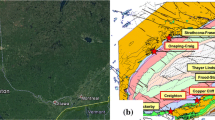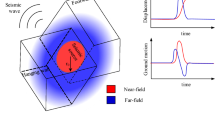Abstract
Mining-induced seismic events greatly threaten safety of underground workers and studying major seismic events would help mitigate hazards in deep mines. Characterizing the aftershock sequence of major events can contribute to developing a reentry protocol after major events occur at mines. This study uses two major events and their aftershock sequences at Creighton Mine to investigate properties of aftershock sequences focusing on the magnitude of completeness and aftershock decay pattern. Two major events with moment magnitude 3.1 and 1.4 are analyzed, respectively, and their aftershock sequence are examined in this study. The optimal magnitude of completeness is rigorously determined by evaluating the goodness of fit using the maximum likelihood method. Then, parameters of aftershock decay using the MOL are estimated. We identify that the p-value of the two studied events is slightly larger than 0.8. This parametrization process using the MOL can assist in better understanding aftershock sequences of mining-induced major events and therefore mitigating seismic hazards in mining by potentially helping establish a reentry protocol based on the seismicity dropping below a certain rate. For establishing a reentry protocol, the study of the two events can be considered as a methodological work and a future statistical work for many events with different magnitudes and locations to establish the range of the MOL parameters is needed.
Graphical abstract








Similar content being viewed by others
References
Barton N, Pandey SK (2011) Numerical modelling of two stoping methods in two Indian mines using degradation of c and mobilization of φ based on Q-parameters. Int J Rock Mech Min Sci 48:1095–1112. https://doi.org/10.1016/J.IJRMMS.2011.07.002
Båth M (1965) Lateral inhomogeneities of the upper mantle. Tectonophysics 2(6):483–514
Beck DA, Brady BHG (2002) Evaluation and application and controlling parameters for seismic events in hard-rock mines. Int J Rock Mech Min Sci 39:633–642. https://doi.org/10.1016/S1365-1609(02)00061-8
Bogucki R, Lasek J, Milczek Jk, Tadeusiak M (2016). Early warning system for seismic events in coal mines using machine learning. In 2016 federated conference on computer science and information systems (FedCSIS) 2016 Sep 11 (pp. 213–220). IEEE
Brady BHG, Brown ET (2007) Rock mechanics and mining engineering. Rock mechanics for underground mining. Springer, Dordrecht, pp 1–16
Brady B, Leighton F (1977) Seismicity anomaly prior to a moderate rock burst: a case study. Int J Rock Mech Min Sci Geomech Abstr 14(3):127–132
Brown L, Hudyma M (2017a) Identifying local stress increase using a relative apparent stress ratio for populations of mining-induced seismic events. Can Geotech J 54:128–137. https://doi.org/10.1139/cgj-2016-0050
Brown L, Hudyma M (2017b) Identification of stress change within a rock mass through apparent stress of local seismic events. Rock Mech Rock Eng 50:81–88. https://doi.org/10.1007/s00603-016-1092-z
Disley N (2014). Seismic risk and hazard management at Kidd Mine. In: Proceedings of the seventh international conference on deep and high stress mining (107–121). Australian Centre for Geomechanics
Elisabeth C (2011) New approaches towards understanding and forecasting induced seismicity (Doctoral dissertation, ETH Zurich). https://doi.org/10.3929/ethz-a-006715437
Gutenberg B, Richter C (1944) Frequency of earthquakes in California. Bull Seismol Soc Am 34(4):185–188
Goebel THW, Schorlemmer D, Becker TW et al (2013) Acoustic emissions document stress changes over many seismic cycles in stick-slip experiments. Geophys Res Lett 40:2049–2054. https://doi.org/10.1002/grl.50507
Helmstetter A, Sornette D (2002) Subcritical and supercritical regimes in epidemic models of earthquake aftershocks. J Geophys Res Solid Earth 107(B10):ESE 10-1-ESE 10-21
Holschneider M, Narteau C, Shebalin P et al (2012) Bayesian analysis of the MOL. J Geophys Res Solid Earth. https://doi.org/10.1029/2011JB009054
Hudyma M, Potvin Y (2010) An engineering approach to seismic risk management in hardrock mines. Rock Mech Rock Eng 43(6):891–906
Kagan YY (2011) Random stress and Omori′ s law. Geophys J Int 186(3):1347–1364
Kisslinger C, Jones LM (1991) Properties of aftershock sequences in southern California. J Geophys Res Solid Earth 96(B7):11947–11958. https://doi.org/10.1029/91jb01200
Klein FW, Wright T, Nakata J (2006) Aftershock decay, productivity, and stress rates in Hawaii: indicators of temperature and stress from magma sources. J Geophys Res Solid Earth 111:1–26. https://doi.org/10.1029/2005JB003949
Llenos AL, Michael AJ (2013) Modeling earthquake rate changes in Oklahoma and Arkansas: possible signatures of induced seismicity. Bull Seismol Soc Am 103(5):2850–2861. https://doi.org/10.1785/0120130017
Luxbacher K, Westman E, Swanson P, Karfakis M (2008) Three-dimensional time-lapse velocity tomography of an underground longwall panel. Int J Rock Mech Min Sci 45:478–485. https://doi.org/10.1016/j.ijrmms.2007.07.015
Ma X, Westman EC, Fahrman BP, Thibodeau D (2016) Imaging of temporal stress redistribution due to triggered seismicity at a deep nickel mine. Geomech Energy Environ 5:55–64. https://doi.org/10.1016/j.gete.2016.01.001
Malek F, Espley S, Yao M, Trifu C (2008) Management of high stress and seismicity at Vale Inco Creighton Mine. In: The 42nd US rock mechanics symposium (USRMS). American rock mechanics association
Marsan D, Bean C, Steacy S (1999) Spatio-temporal analysis of stress diffusion in a mining-induced seismicity system. Geophys Res Lett 26(24):3697–3700
Morikami S, Mitsui Y (2020) Omori-like slow decay (p < 1) of postseismic displacement rates following the 2011 Tohoku megathrust earthquake. Earth Planets Space 72(1):1–10. https://doi.org/10.1186/s40623-020-01162-w
Nyffenegger P, Frohlich C (2000) Aftershock occurrence rate decay properties for intermediate and deep earthquake sequences. Geophys Res Lett 27:1215–1218. https://doi.org/10.1029/1998GL010371
Omi T, Ogata Y, Hirata Y, Aihara K (2013) Forecasting large aftershocks within one day after the main shock. Sci Rep 3:2218. https://doi.org/10.1038/srep02218
Omori F (1894) On the after-shocks of earthquakes. J Coll Sci Imp Univ Jpn 7:111–200
Ouillon G, Sornette D (2005) Magnitude-dependent Omori law: theory and empirical study—magnitude-dependent Omori law. J Geophys Res Solid Earth. https://doi.org/10.1029/2004JB003311
Parsons T (2002) Global Omori law decay of triggered earthquakes: large aftershocks outside the classical aftershock zone: global Omori law decay of triggered earthquakes. J Geophys Res Solid Earth 107(B9):ESE 9-1-ESE 9-20. https://doi.org/10.1029/2001JB000646
Schoenberg FP (2013) Facilitated estimation of ETAS. Bull Seismol Soc Am 103(1):601–605. https://doi.org/10.1785/0120120146
Schorlemmer D, Wiemer S, Wyss M (2005) Variations in earthquake-size distribution across different stress regimes. Nature 437(7058):539–542. https://doi.org/10.1038/nature04094
Shaw B (1993) Generalized Omori law for aftershocks and foreshocks from a simple dynamics. Geophys Res Lett 20(10):907–910
Shcherbakov R, Turcotte DL, Rundle JB (2005) Aftershock statistics. Pure Appl Geophys 162:1051–1076. https://doi.org/10.1007/s00024-004-2661-8
Shcherbakov R, Turcotte DL, Rundle JB (2004) A generalized Omori’s law for earthquake aftershock decay: a generalized Omori’s law. Geophys Res Lett 31(11):n/a-n/a. https://doi.org/10.1029/2004GL019808
Shi Y, Bolt BA (1982) The standard error of the magnitude-frequency b value. Bull of the Seismol Soc Am 72(5):1677–1687. https://doi.org/10.1785/BSSA0720051677
Tierney R, Morkel G (2017) The optimisation and comparison of re-entry assessment methodologies for use in seismically active mines. In: Proceedings of the eighth international conference on deep and high stress mining (183–196). Australian centre for geomechanics
Urbancic T, Trifu C, Young R (1993) Microseismicity derived fault-planes and their relationship to focal mechanism, stress inversion, and geologic data. Geophys Res Lett 20(22):2475–2478
Utsu T (1961) A statistical study on the occurrence of aftershocks. Geophys Mag 30:521–605
Utsu T, Ogata Y (1995) The centenary of the Omori formula for a decay law of aftershock activity. J Phys Earth 43(1):1–33
Utsu T, Seki A (1954) A relation between the area of aftershock region and the energy of main shock. J Seism Soc Jpn 7:233–240
Vallejos JA, McKinnon SM (2009). Re-entry protocols for seismically active mines using statistical analysis of aftershock sequences. In rock engineering in difficult conditions. In: Proceedings of the 20th Canadian rock mechanics symposium, Toronto, Canada, paper (Vol. 4028)
Vallejos J, Estay R (2018) Seismic parameters of mining-induced aftershock sequences for re-entry protocol development. Pure Appl Geophys 175(3):793–811
Vallejos J, McKinnon S (2010) Omori’s law applied to mining-induced seismicity and re-entry protocol development. Pure Appl Geophys 167:91–106. https://doi.org/10.1007/s00024-009-0010-7
Vallejos J, McKinnon S (2011) Correlations between mining and seismicity for re-entry protocol development. Int J Rock Mech 48(4):616–625
Wang C-Y, Manga M (2010) Earthquakes influenced by water. Springer, Heidelberg, pp 125–139
Wesnousky S (1994) The Gutenberg–Richter or characteristic earthquake distribution, which is it? Bull Seismol Soc Am 84(6):1940–1959
Wesnousky S (1999) Crustal deformation processes and the stability of the Gutenberg–Richter relationship. Bull Seismol Soc Am 89(4):1131–1137
Wiemer S, Wyss M (1997) Mapping the frequency-magnitude distribution in asperities: an improved technique to calculate recurrence times? J Geophys Res Solid Earth 102(B7):15115–15128. https://doi.org/10.1029/97jb00726
Xu YH, Cai M (2017) Influence of loading system stiffness on post-peak stress-strain curve of stable rock failures. Rock Mech Rock Eng 50:2255–2275. https://doi.org/10.1007/s00603-017-1231-1
Young RP, Maxwell SC (1992) Seismic characterization of a highly stressed rock mass using tomographic imaging and induced seismicity. J Geophys Res Earth 97:12361–12373
Zhuang J, Murru M, Falcone G, Guo Y (2019) An extensive study of clustering features of seismicity in Italy from 2005 to 2016. Geophys J Int 216(1):302–318
Acknowledgements
The author Xu Ma acknowledge the China National Key Research and Development Program (Grant: 2021YFC3000603). Vale Canada Limited provided the field data for this study. Support for this project came from the Canadian Mining Industry Research Organization and a NIOSH Ground Control Capacity Building Grant (Contract 200-2011-40313). We thank Editor Savka Dineva for the insightful comments.
Author information
Authors and Affiliations
Corresponding author
Ethics declarations
Conflict of interest
The authors declare that they have no conflict of interest.
Additional information
Edited by Prof. Savka Dineva (CO-EDITOR-IN-CHIEF).
Rights and permissions
About this article
Cite this article
Ma, X., Westman, E., Malek, F. et al. The aftershock sequence at a deep nickel mine: temporal and spatial distribution, magnitude distribution, and aftershock decay following major events. Acta Geophys. 70, 1241–1252 (2022). https://doi.org/10.1007/s11600-022-00770-2
Received:
Accepted:
Published:
Issue Date:
DOI: https://doi.org/10.1007/s11600-022-00770-2




